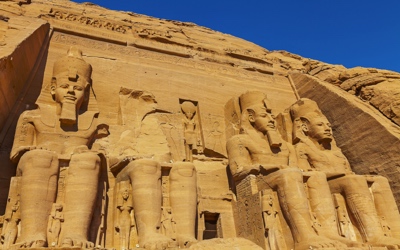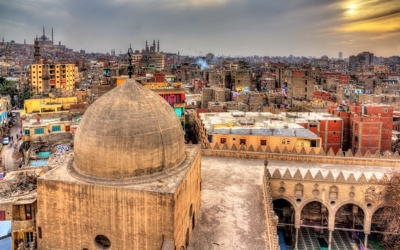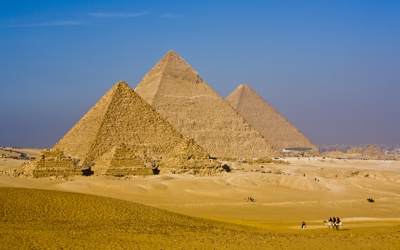
Cairo by bus guided group tour, Pyramids, Egyptian Museum,Lunch and Shopping
1 day
Déjeuner
Avec un guide
En groupe
Confirmation instantanée
A propos de cette activités
Itinerary
This is a typical itinerary for this product
Stop At: Pyramids of Giza, Al Haram Str., Giza 12611 Egypt
The last remaining wonder of the ancient world; for nearly 4000 years, the extraordinary shape, impeccable geometry and sheer bulk of the Giza Pyramids have invited the obvious questions: ‘How were we built, and why?’. Centuries of research have given us parts of the answer. Built as massive tombs on the orders of the pharaohs, they were constructed by teams of workers tens-of-thousands strong. Today they stand as an awe-inspiring tribute to the might, organisation and achievements of ancient Egypt.
Ongoing excavations on the Giza Plateau, along with the discovery of a pyramid-builders' settlement, complete with areas for large-scale food production and medical facilities, have provided more evidence that the workers were not the slaves of Hollywood tradition, but an organised workforce of Egyptian farmers. During the flood season, when the Nile covered their fields, the same farmers could have been redeployed by the highly structured bureaucracy to work on the pharaoh’s tomb. In this way, the Pyramids can almost be seen as an ancient job-creation scheme. And the flood waters made it easier to transport building stone to the site.
But despite the evidence, some still won’t accept that the ancient Egyptians were capable of such achievements. So-called pyramidologists point to the carving and placement of the stones, precise to the millimetre, and argue the numerological significance of the structures’ dimensions as evidence that the Pyramids were constructed by angels or aliens. It’s easy to laugh at these out-there ideas, but when you see the monuments up close, especially inside, you’ll better understand why so many people believe such awesome structures must have unearthly origins.
Most visitors will make a beeline straight to the four most famous sights; the Great Pyramid of Khufu, the Pyramid of Khafre, the Pyramid of Menkaure and the Sphinx. But for those who want to explore further, the desert plateau surrounding the pyramids is littered with tombs, temple ruins and smaller satellite pyramids.
Duration: 2 hours
Stop At: Egyptian Antiquities Museum, Midan El Tahrir Geographical Society Building, Cairo 11511 Egypt
One of the world’s most important collections of ancient artefacts, the Egyptian Museum takes pride of place in Downtown Cairo, on the north side of Midan Tahrir. Inside the great domed, oddly pinkish building, the glittering treasures of Tutankhamun and other great pharaohs lie alongside the grave goods, mummies, jewellery, eating bowls and toys of Egyptians whose names are lost to history.
To walk around the museum is to embark on an adventure through time.
Some display cards have become obsolete as new discoveries have busted old theories. And the collection rapidly outgrew its sensible layout, as, for instance, Tutankhamun’s enormous trove and the tomb contents of Tanis were both unearthed after the museum opened, and then had to be shoehorned into the space. Now more than 100,000 objects are wedged into about 15,000 sq metres. Like the country itself, the museum is in flux. Most objects are still on display, although some are being moved to the Grand Egyptian Museum. While some rooms are being refurbished, the objects are deposited elsewhere in the museum. This museum will remain a major sight, but it is not yet clear when the Grand will open and what will remain here.
The current museum has its origins in several earlier efforts at managing Egypt’s ancient heritage, beginning in 1835 when Egyptian ruler Mohammed Ali banned the export of antiquities. French architect Mariette’s growing collection, from 35 dig sites, bounced around various homes in Cairo until 1902, when the current building was erected, in a suitably prominent position in the city. There it has stood, in its original layout, a gem of early museum design.
Until 1996, museum security involved locking the door at night. When an enterprising thief stowed away overnight and helped himself to treasures, the museum authorities installed alarms and detectors, at the same time improving the lighting on many exhibits. During the 2011 revolution, the museum was broken into and a few artefacts went missing. To prevent further looting, activists formed a human chain around the building to guard its contents. By most reports, they were successful.
Duration: 2 hours
Read more
Voir moins
This is a typical itinerary for this product
Stop At: Pyramids of Giza, Al Haram Str., Giza 12611 Egypt
The last remaining wonder of the ancient world; for nearly 4000 years, the extraordinary shape, impeccable geometry and sheer bulk of the Giza Pyramids have invited the obvious questions: ‘How were we built, and why?’. Centuries of research have given us parts of the answer. Built as massive tombs on the orders of the pharaohs, they were constructed by teams of workers tens-of-thousands strong. Today they stand as an awe-inspiring tribute to the might, organisation and achievements of ancient Egypt.
Ongoing excavations on the Giza Plateau, along with the discovery of a pyramid-builders' settlement, complete with areas for large-scale food production and medical facilities, have provided more evidence that the workers were not the slaves of Hollywood tradition, but an organised workforce of Egyptian farmers. During the flood season, when the Nile covered their fields, the same farmers could have been redeployed by the highly structured bureaucracy to work on the pharaoh’s tomb. In this way, the Pyramids can almost be seen as an ancient job-creation scheme. And the flood waters made it easier to transport building stone to the site.
But despite the evidence, some still won’t accept that the ancient Egyptians were capable of such achievements. So-called pyramidologists point to the carving and placement of the stones, precise to the millimetre, and argue the numerological significance of the structures’ dimensions as evidence that the Pyramids were constructed by angels or aliens. It’s easy to laugh at these out-there ideas, but when you see the monuments up close, especially inside, you’ll better understand why so many people believe such awesome structures must have unearthly origins.
Most visitors will make a beeline straight to the four most famous sights; the Great Pyramid of Khufu, the Pyramid of Khafre, the Pyramid of Menkaure and the Sphinx. But for those who want to explore further, the desert plateau surrounding the pyramids is littered with tombs, temple ruins and smaller satellite pyramids.
Duration: 2 hours
Stop At: Egyptian Antiquities Museum, Midan El Tahrir Geographical Society Building, Cairo 11511 Egypt
One of the world’s most important collections of ancient artefacts, the Egyptian Museum takes pride of place in Downtown Cairo, on the north side of Midan Tahrir. Inside the great domed, oddly pinkish building, the glittering treasures of Tutankhamun and other great pharaohs lie alongside the grave goods, mummies, jewellery, eating bowls and toys of Egyptians whose names are lost to history.
To walk around the museum is to embark on an adventure through time.
Some display cards have become obsolete as new discoveries have busted old theories. And the collection rapidly outgrew its sensible layout, as, for instance, Tutankhamun’s enormous trove and the tomb contents of Tanis were both unearthed after the museum opened, and then had to be shoehorned into the space. Now more than 100,000 objects are wedged into about 15,000 sq metres. Like the country itself, the museum is in flux. Most objects are still on display, although some are being moved to the Grand Egyptian Museum. While some rooms are being refurbished, the objects are deposited elsewhere in the museum. This museum will remain a major sight, but it is not yet clear when the Grand will open and what will remain here.
The current museum has its origins in several earlier efforts at managing Egypt’s ancient heritage, beginning in 1835 when Egyptian ruler Mohammed Ali banned the export of antiquities. French architect Mariette’s growing collection, from 35 dig sites, bounced around various homes in Cairo until 1902, when the current building was erected, in a suitably prominent position in the city. There it has stood, in its original layout, a gem of early museum design.
Until 1996, museum security involved locking the door at night. When an enterprising thief stowed away overnight and helped himself to treasures, the museum authorities installed alarms and detectors, at the same time improving the lighting on many exhibits. During the 2011 revolution, the museum was broken into and a few artefacts went missing. To prevent further looting, activists formed a human chain around the building to guard its contents. By most reports, they were successful.
Duration: 2 hours
Inclus
- All taxes, fees and handling charges
- Professional guide
- Hotel pickup and drop-off
- Fuel surcharge
- Lunch
- Qualified Egyptologist guide
- Tour escort/host
- Entry/Admission - Pyramids of Giza
- Entry/Admission - Egyptian Antiquities Museum
Non inclus
- Gratuities
- Drinks
- Food and drinks, unless specified
- Souvenir photos (available to purchase)
- DVD (available to purchase)
- Transfers outside Hurghada incur a 10 GBP per person surcharge
Autres informations
- Confirmation will be received at time of booking
- Wheelchair accessible
- Children must be accompanied by an adult
- This tour/activity will have a maximum of 35 travelers
Caractéristiques
Tourisme
90%
Culturel
75%
Vous devriez aussi aimer









 Tout voir 26 Collections
Tout voir 26 Collections
Cliquez pour dévouvrir d'autres expériences
Tout voir

Collections
Bedouin Village
8 Activités

Collections
Adventure park
5 Activités

Collections
Paradise & Utopia Islands
9 Activités

Collections
Sports
11 Activités

Collections
History & Culture
8 Activités

Collections
Snorkeling
36 Activités

Collections
Desert Safari
37 Activités

Collections
Cairo trip
43 Activités

Collections
By bus
21 Activités

Collections
Quad
23 Activités



